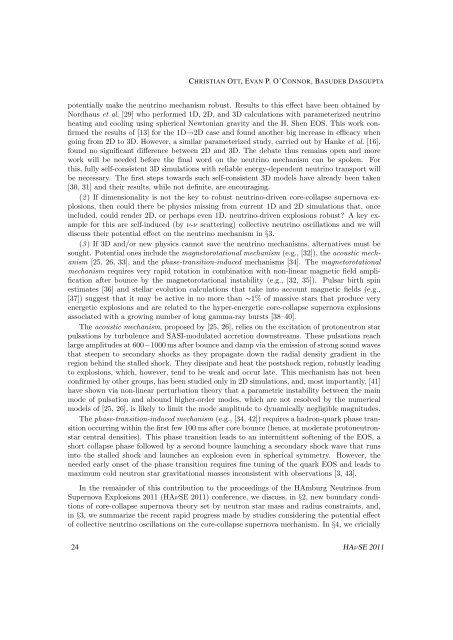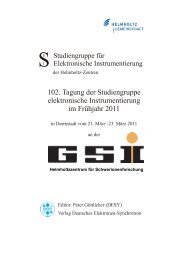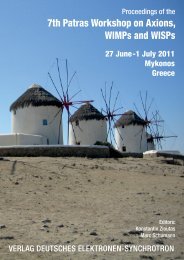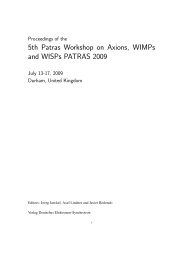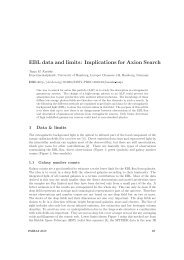Hamburg Neutrinos from Supernova Explosions ... - DESY Library
Hamburg Neutrinos from Supernova Explosions ... - DESY Library
Hamburg Neutrinos from Supernova Explosions ... - DESY Library
You also want an ePaper? Increase the reach of your titles
YUMPU automatically turns print PDFs into web optimized ePapers that Google loves.
CHRISTIAN OTT, EVAN P. O’CONNOR, BASUDEB DASGUPTA<br />
potentially make the neutrino mechanism robust. Results to this effect have been obtained by<br />
Nordhaus et al. [29] who performed 1D, 2D, and 3D calculations with parameterized neutrino<br />
heating and cooling using spherical Newtonian gravity and the H. Shen EOS. This work confirmed<br />
the results of [13] for the 1D→2D case and found another big increase in efficacy when<br />
going <strong>from</strong> 2D to 3D. However, a similar parameterized study, carried out by Hanke et al. [16],<br />
found no significant difference between 2D and 3D. The debate thus remains open and more<br />
work will be needed before the final word on the neutrino mechanism can be spoken. For<br />
this, fully self-consistent 3D simulations with reliable energy-dependent neutrino transport will<br />
be necessary. The first steps towards such self-consistent 3D models have already been taken<br />
[30, 31] and their results, while not definite, are encouraging.<br />
(2 ) If dimensionality is not the key to robust neutrino-driven core-collapse supernova explosions,<br />
then could there be physics missing <strong>from</strong> current 1D and 2D simulations that, once<br />
included, could render 2D, or perhaps even 1D, neutrino-driven explosions robust? A key example<br />
for this are self-induced (by ν-ν scattering) collective neutrino oscillations and we will<br />
discuss their potential effect on the neutrino mechanism in §3.<br />
(3 ) If 3D and/or new physics cannot save the neutrino mechanisms, alternatives must be<br />
sought. Potential ones include the magnetorotational mechanism (e.g., [32]), the acoustic mechanism<br />
[25, 26, 33], and the phase-transition-induced mechanisms [34]. The magnetorotational<br />
mechanism requires very rapid rotation in combination with non-linear magnetic field amplification<br />
after bounce by the magnetorotational instability (e.g., [32, 35]). Pulsar birth spin<br />
estimates [36] and stellar evolution calculations that take into account magnetic fields (e.g.,<br />
[37]) suggest that it may be active in no more than ∼1% of massive stars that produce very<br />
energetic explosions and are related to the hyper-energetic core-collapse supernova explosions<br />
associated with a growing number of long gamma-ray bursts [38–40].<br />
The acoustic mechanism, proposed by [25, 26], relies on the excitation of protoneutron star<br />
pulsations by turbulence and SASI-modulated accretion downstreams. These pulsations reach<br />
large amplitudes at 600−1000 ms after bounce and damp via the emission of strong sound waves<br />
that steepen to secondary shocks as they propagate down the radial density gradient in the<br />
region behind the stalled shock. They dissipate and heat the postshock region, robustly leading<br />
to explosions, which, however, tend to be weak and occur late. This mechanism has not been<br />
confirmed by other groups, has been studied only in 2D simulations, and, most importantly, [41]<br />
have shown via non-linear perturbation theory that a parametric instability between the main<br />
mode of pulsation and abound higher-order modes, which are not resolved by the numerical<br />
models of [25, 26], is likely to limit the mode amplitude to dynamically negligible magnitudes.<br />
The phase-transition-induced mechanism (e.g., [34, 42]) requires a hadron-quark phase transition<br />
occurring within the first few 100 ms after core bounce (hence, at moderate protoneutronstar<br />
central densities). This phase transition leads to an intermittent softening of the EOS, a<br />
short collapse phase followed by a second bounce launching a secondary shock wave that runs<br />
into the stalled shock and launches an explosion even in spherical symmetry. However, the<br />
needed early onset of the phase transition requires fine tuning of the quark EOS and leads to<br />
maximum cold neutron star gravitational masses inconsistent with observations [3, 43].<br />
In the remainder of this contribution to the proceedings of the HAmburg <strong>Neutrinos</strong> <strong>from</strong><br />
<strong>Supernova</strong> <strong>Explosions</strong> 2011 (HAνSE 2011) conference, we discuss, in §2, new boundary conditions<br />
of core-collapse supernova theory set by neutron star mass and radius constraints, and,<br />
in §3, we summarize the recent rapid progress made by studies considering the potential effect<br />
of collective neutrino oscillations on the core-collapse supernova mechanism. In §4, we cricially<br />
Proceedings 24 of HAνSE 2011 HAνSE 2011<br />
3


